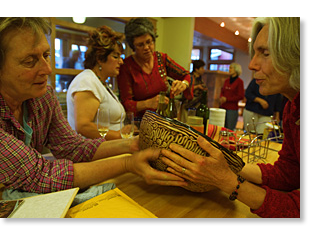|
|

 |
In a world where the extended family tends to be spread all over the country, there’s nothing like having neighbors that you can ask about children’s earaches and other daily dilemmas that you would traditionally look to your family for.
— Charles Durrett , architect, author
Cohousing: A Contemporary Approach to Housing Ourselves
|
|
|
|
Dynamics of Community
(Or, Now that We're Neighbors, How Can We Get Along?)
There’s a growing desire from people of all ages to live in more closely-knit communities. The reality of living in a tighter neighborhood, however, may be more challenging than rosy dreams. Issues come up that rub people the wrong way—resentments that others aren’t doing their fair share of work,  irritation with kids playing too loudly, or exasperation with the neighbor’s dog digging in garden (again). As well, living in a community means needing to make decisions together— should a diseased tree be taken down? What is an appropriate assessment for building maintenance and repairs? How tight or loose should the covenants be, and how should they be enforced? irritation with kids playing too loudly, or exasperation with the neighbor’s dog digging in garden (again). As well, living in a community means needing to make decisions together— should a diseased tree be taken down? What is an appropriate assessment for building maintenance and repairs? How tight or loose should the covenants be, and how should they be enforced?
Fortunately, there are many more communications and decision-making tools available today than there were ten or twenty years ago that can help neighbors work through their differences and make decisions as a group.
While this website is primarily focused on the physical design and planning of small-scale communities, we want to highlight a few of these tools to make living in community a healthy, rewarding experience.
A significant part of the Pocket Neighborhood Book is devoted to cohousing communities, of which there are now 100s of examples around the world. These are communities of up to around 30 households each that are planned, owned and managed by the residents themselves. Most have developed forms of consensus decision-making processes, and have tools for working through issues and irritations that arise. Start by checking out the Group Process section of the Cohousing Website.
One of the clearest and most helpful guides we've seen for communities is a self-published workbook titled, "Head, Heart & Hands: Lessons in Community Building", by Shari Leach of the Wonderland Hill Development Company. Contact them for more information.
Tree Bressen has a very helpful compilation of articles originally written for people living in intentional communities, and is herself a terrific resource call on to assist any group.
Robert Sandelin has a straightforward description of the consensus decision-making process and how it is used in groups.
Consensus Decision-Making.org is a virtual learning center for people interested in making decisions by consensus.
Diana Leafe Christian is the author of Creating a Life Together , a book with practical information for establishing and sustaining communities, including sections on communications and decision-making tools. Diana also has a blog on the Cohousing Website with stories and perspectives about living in community.
And finally, check out our Resources Section on this site for additional information.
We welcome your own suggestions and links that we might consider including on this site—write to us at Contact & Comments. |
|